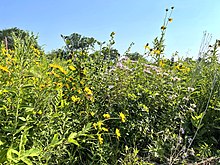

Cemetery prairies are remnants of native North American prairie that survive on land set aside by settlers as burial grounds. These places were thus left unplowed and largely undisturbed, such that the cemeteries became de facto nature preserves.[1] Natural prairie grasses are often perennial species that regrow from the roots after ruminant grazing or grassfire; plowing destroys the root system and eventually the ecosystem.
Native prairie is now vanishingly rare, so any surviving patches are considered precious. According to prairie researcher John Madson in 1974, "Most surviving tallgrass prairie preserves are relatively small. In Iowa or Illinois, as much as a square mile of virgin tallgrass prairie would be a huge and immensely valuable tract."[2] Iowa is estimated to have 200 to 300 relic cemetery prairies[3] totaling about 1,000 acres (400 ha; 1.6 sq mi; 4.0 km2),[4] which is thought to be less than 0.1 percent of the state's original native grassland.[5] Missouri has approximately 60,000 acres (24,000 ha; 94 sq mi; 240 km2) of original prairie, which is a larger absolute area but nonetheless still less than 0.5 percent of the prairie extent pre-settlement.[6] Only about 2,300 acres (930 ha; 3.6 sq mi; 9.3 km2)[7] of original prairie are left in Illinois, the Prairie State.[8] Fifty of those Illinois acres are found within 29 historic cemeteries.[7] In addition to cemetery prairies, other remnants of original prairie persisted on sand ridges and rocky hillsides unsuitable for agriculture, and along railroad rights-of-way.[9]
Remnant cemetery prairies are valuable control groups or points of comparison for scientific studies of degraded or restored grasslands.[9][10] The genetic material preserved in these remnants[11] can be drawn upon for larger ecological restorations.[12] Scientists also use cemeteries, generally, to measure topsoil erosion.[13] One cemetery prairie in Plainview, Illinois stands at least 1 ft (30 cm) above the surrounding cornfield, illustrating the difference in soil retention rates of perennial versus cultivated annual vegetation.[9]
Some cemetery prairies have been abandoned over time, and some remain active community burial grounds. In both circumstances, maintenance, management and local politics are often ongoing challenges to preservation.[5][14][15] Similarly, roads and paths that once led to the cemeteries may have disappeared over time, which simultaneously proffers a measure of security through obscurity and as a practical matter somewhat hinders preservation efforts.[16]
- ^ Cite error: The named reference
stlouisdispatchwas invoked but never defined (see the help page). - ^ Madson, John (2009). Where The Sky Began: Land of the Tallgrass Prairie. University of Iowa Press. ISBN 9780877458616. OCLC 794701545. Retrieved January 24, 2023 – via Project MUSE.
- ^ "Ex-resident's advice on saving prairie". The Humboldt Independent. August 30, 1975. p. 9. Retrieved January 9, 2023 – via Newspapers.com.
- ^ Wallbaum, Mary (July 4, 1976). "Prairie Grass Obstacle at First". The Gazette. Cedar Rapids, Iowa. p. 144. Retrieved January 9, 2023 – via Newspapers.com.
- ^ a b Samuels, Sam Hooper (July–August 2009). "Hallowed Prairie" (PDF). Iowa Outdoors. Photographs by Clay Smith. Iowa Department of Natural Resources. pp. 29–35.
- ^ Missouri Department of Conservation; Missouri Prairie Foundation. "Public Prairies of Missouri Interactive Story Map".
- ^ a b Cite error: The named reference
:5was invoked but never defined (see the help page). - ^ Starr, Douglas (April 5, 1992). "A Prairie's Boon Companion In Illinois, one man's dream of a field grows bigger every day". Sports Illustrated. Vol. 76, no. 13. pp. 7–unk.
- ^ a b c Cite error: The named reference
:3was invoked but never defined (see the help page). - ^ Gustafson, Danny J.; Gibson, David J.; Nickrent, Daniel L. (November 2002). "Genetic Diversity and Competitive Abilities of Dalea purpurea (Fabaceae) from Remnant and Restored Grasslands". International Journal of Plant Sciences. 163 (6): 979–990. doi:10.1086/342709. ISSN 1058-5893. S2CID 55179493.
- ^ Gustafson, Danny J; Gibson, David J; Nickrent, Daniel L (April 2005). "Using Local Seeds in Prairie Restoration Data Support the Paradigm". Native Plants Journal. 6 (1): 25–28. doi:10.2979/NPJ.2005.6.1.25. ISSN 1522-8339. S2CID 83748942.
- ^ "Pioneer Graveyard Site of Champaign County's Best-Preserved Prairie". The Times. Munster, Indiana. November 30, 2001. p. 20. Retrieved January 9, 2023 – via Newspapers.com.
- ^ Geleta, S. B.; Briand, C. H.; Folkoff, M. E.; Zaprowski, B. J. (2014). "Cemeteries as Indicators of Post-Settlement Anthropogenic Soil Degradation on the Atlantic Coastal Plain". Human Ecology. 42 (4): 625–635. doi:10.1007/s10745-014-9665-5. ISSN 0300-7839. JSTOR 24013866. S2CID 254544845.
- ^ Cite error: The named reference
siouxcitywas invoked but never defined (see the help page). - ^ Cite error: The named reference
RochesterAP2006was invoked but never defined (see the help page). - ^ D'Alessandro, Domenico (Fall 2010). "Sacred Space and Restoration Ecology". Erigenia (24). Illinois Native Plant Society: 3–4.